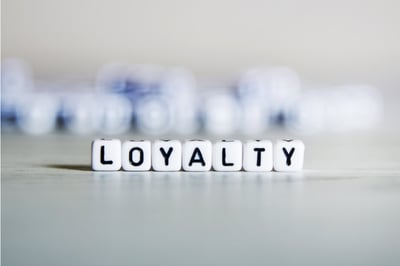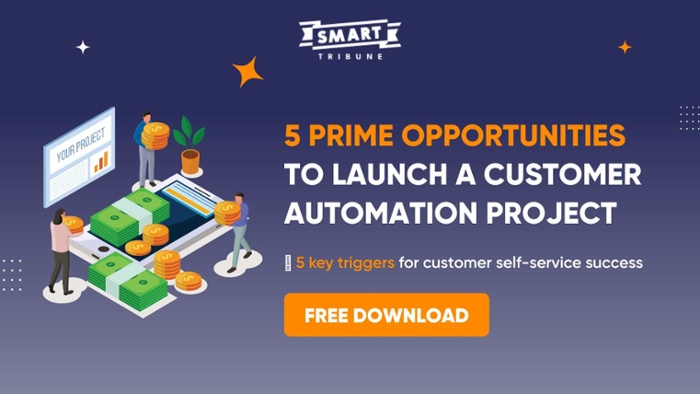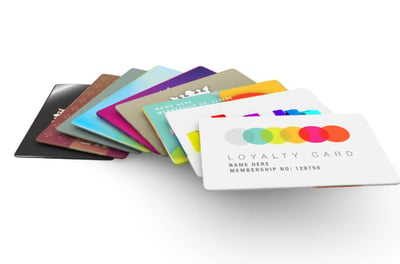
This isn’t new news to anyone: It costs companies a lot more to attract new customers than it does to nurture and retain existing customers. In fact, the Harvard Business Review (HBR) found that, in some cases, new customer acquisition can be up to 25 times more costly. So, you’d think that most companies would double down on their customer retention efforts to ensure that loyal customers don’t feel a need to jump ship to a competitor brand. But the challenge here is that not all customers are created equal—or, in other words, not every customer that makes an initial purchase with your brand or business is going to stick around for the long haul. This has created the double-edged sword of keeping both the new customer acquisition and customer retention engines at full throttle at all times.
While there are a lot of ways to encourage existing customers to continue being returning customers, one of the best and most effective ways to do this is via customer loyalty programs. If your company doesn’t yet have a customer loyalty program of its own—or is just in the early stages of building one—this article is for you. Here, we’ll take a closer look at all of the benefits that go hand-in-hand with building and deploying a customer loyalty program.
Table of content:
- Customer loyalty: What is it, and why is it important?
- What are the benefits of customer loyalty programs?
- Create a better customer experience with a loyalty program
Customer loyalty: What is it, and why is it important?
According to HubSpot, customer loyalty is defined as a “customer's willingness to repeatedly return to a company to conduct business. This is typically due to the delightful and remarkable experiences they have with that brand.” Therefore, it almost goes without saying that customer loyalty is essentially what every company strives for—because, after all, a business can’t flourish and grow without the support of its customers.
However, one thing that’s important to call out in Hubspot’s definition of customer loyalty is the part about it being the direct outcome of customers having a “delightful and remarkable experience” with a brand or business. This part is essential to winning on the customer loyalty front and get the reward because today, a whopping 96 percent of customers say that they are willing to leave a brand after only a single bad customer service experience.
But truth be told, this knee-jerk reaction goes well beyond the customer service experience alone. When customers are faced with a subpar experience at any point along the customer journey—whether it’s the result of a less-than-user-friendly mobile site experience or dissatisfaction with the product or service purchased—that can be enough to plant a seed in a customer’s head to consider alternate options.
This is why it’s important for brands and businesses to keep a pulse on customer happiness at all times. Not only is this critical for the long-term health of any business, but it can also influence decision-making in a big way. Let’s take a closer look at how data is used to do that.
How is customer loyalty measured?
There are a lot of different ways that companies can measure customer loyalty:
- Customer Satisfaction (CSAT): As the name suggests, this is a fairly direct way to see if your customers are satisfied or dissatisfied with their experience with your business, more generally speaking, or with the products and services you offer. Customers are typically prompted with questions that can be answered on a four-tier satisfaction scale—from “Very Satisfied” to “Very Dissatisfied.” Generating the CSAT score is just a matter of dividing the number of responses that received a “Very Satisfied” or “Somewhat Satisfied” rating, dividing that number by the total number of responses requested, and then multiplying that by 100 to get a percentage. This is a great way to get a quick snapshot of customer satisfaction in real-time. In this way, CSAT is a reference to a customer’s past experiences and not necessarily an indicator of future behaviour.
- Net Promoter Score® (NPS): This metric captures another dimension of customer satisfaction: How willing customers are to recommend a brand, product, or service to someone else in their own inner circle. Oftentimes, customers respond to simple survey questions on a 0-10 scale, where those responding in the 9-10 range are considered “net promoters” while anyone averaging a score of 6 or below is a “net detractor.”
Why is this important? First, if your customers like the experience they have with your brand or business, you’d hope that they’d pay it forward by singing the praises to their friends, family, colleagues, etc, which create more loyal customers - the reward that every business try to work hard to get. As you would imagine, businesses want the vast majority of their customers to fall into this category—as it can help identify who they can tap into to be their biggest ambassadors. However, on the flip side, when you also know who your biggest “detractors” are, you can learn more about where the experience is lacking and then take steps to help improve that experience. This, therefore, makes the NPS metric a great way to manage both sides of customer loyalty. - Customer Effort Score (CES): This metric is more closely tied to the customer service experience than the other two above. Essentially, it measures how much effort customers have to make themselves when attempting to resolve an issue or get a question answered. Basically, the lower the score, the better, as that means it requires less effort on the customer’s end to resolve an issue. Companies tend to measure CES because it sheds light on the actual experience customers have when completing a “task,” so to speak, and less about their emotional relationship to a brand or business.
- Customer Happiness Index (CHI): This measures how likely a customer will jump ship and seek out a competitor brand that offers the same products and services as those your business offers. This is both an indicator of likely churn coupled with the reasons why those customers are considering doing business with another brand. Obviously, the goal here is twofold. First, it’s about getting a pulse on general customer happiness, so you can continue creating positive experiences for those happy customers. Second, it’s about identifying who’s about to churn quickly and, if possible, implementing key improvements or changes that can move customers up the “happy scale.”

- Customer Retention Rate (CRR): This captures how long customers stay with your brand from the moment they make their very first purchase until they’ve essentially gone AWOL (without making any repeat purchases in a long time). In most cases, the longer customers stick around and keep on purchasing, the less motivated they’ll be to put the feelers out and test out other brands. So, why does customer retention matter? For one, it’s been found that increasing customer retention by up to 10% can boost your company’s profits by 30%—and sometimes well beyond that.
But customer retention is also a byproduct of customer satisfaction and customer happiness. In other words, if you continue to provide top-notch products and services to your customers—and marry that with an end-to-end customer experience that surprises and delights—they will have much less of a reason to leave. This is precisely why an increase in customer retention can make a big impact on a business’s bottom line. - Customer Churn: While the CHI score above ties the probability of customer churn to customer happiness, the customer churn metric simply states how many customers have gone quiet and, therefore, aren’t likely to make another purchase. For subscription-based businesses, this number is quite direct, as customer churn pretty much happens the second customers decide to cancel their subscriptions. (Pausing a subscription still leaves a glimmer of hope that they’ll come back!)
- Purchasing Habits: According to HubSpot, it’s also important to take stock of how long it takes for customers to make a repeat purchase, how many customers are processing returns, and a wide variety of other purchasing behaviours that might indicate how soon or how likely a customer might churn. Not only does understanding how your customers engage with your brand give you a more proactive way of pinpointing any obstacles they may be facing along the customer journey, but it can also help you create a more personalised experience that leads to customer satisfaction and happiness.
What are the benefits of customer loyalty programs?
What is a customer loyalty program?
Customer loyalty programs are, more or less, how brands and businesses incentivize customer retention. These programs can take many shapes and forms based on the kind of products and services your business offers or how your customers engage with your brand to satisfy any existing customer and get more loyal customers. For example, a well-known consumer brand that has a cult-like following on social media is likely to have a vastly different customer loyalty program than a B2B SaaS-based business.
That being said, getting a brand loyalty and customer loyalty program off the ground isn’t always easy. As HBR so aptly put it, “No business can make money on customers who are chronic switchers.” Customer loyalty is, after all, a value exchange at its very core. However, the “full potential of value sharing through rewards is realised only when customers become sustainably loyal.”
The key to making them “sustainably loyal” is to provide something that takes their experience with your brand or business to the next level. Maybe it’s about designing a program that allows customers to earn points, based on their purchases or engagement with the brand, and convert those points into some sort of cash value. Or maybe it’s about creating added convenience (à la, free shipping) or providing perks that can only be unlocked by joining the program.
Whatever the case may be, before brands can even convince customers to join these programs, they need to create a stellar customer experience and customer engagement, including consistently good products and services. No customer loyalty program will ever move the needle if the rest of a brand’s experience is subpar. Loyalty is driven, once again, by customer satisfaction and happiness.
The value of customer loyalty programs for companies
Now that we’ve established just how important customer loyalty is for fueling the success of any business, let’s take a closer look at exactly what that means through the lens of business impact.
Here’s a quick rundown of the primary benefits that go hand-in-hand with customer loyalty:
.jpg?width=500&height=651&name=6%20values%20of%20customer%20loyalty%20programs%20for%20companies%20(1).jpg)
- Cut costs: As mentioned at the beginning of this article, it costs a lot less to nurture and retain existing customers than it does to acquire new customers.
While all businesses, to a certain extent, need to engage in both activities, those with a strong returning customer base are less reliant on new customers to grow the bottom line. Another way of looking at it is like this: If you’re successful at consistently growing the amount that existing customers spend and are able to keep them making recurring purchases—which, as a result, also contributes to them having a much higher customer lifetime value (CLV) for your business—then any new customer acquisition efforts you do are simply there to feed that nurture pipeline.
On the other hand, if you have high customer churn, then it’s easy to become overly reliant on new customer acquisition efforts to keep revenues growing. Unfortunately, this can very quickly become a costly “crutch” because the cost to acquire those new customers—who, for all you know, may only make a single purchase and then churn—may not outweigh the investment you made in acquiring them in the first place. - Increase revenue: Bain & Company found that repeat customers who have been loyal to a brand for multiple years will spend 67% more during years two and three of their relationship with your company than a new customer will in their first six months. Add to that the fact that existing customers can be up to 50% more likely to try new products and services as well, versus new customers with whom you are just starting to build a relationship. Customer loyalty is, therefore, a proven vector for revenue growth. But it makes sense because the more customers love your brand and repeat purchase, the more they’ll buy.
- Boost retention: According to Marketing Metrics, repeat customers convert at a rate of 60-70%, whereas new customers may only convert at a rate of 5-20%. While this plays into revenue growth, it’s also an indicator of how willing loyal customers are to support your brand or business for the long haul and brand awareness. Because customer loyalty programs incentivise long-term brand-customer relationships, they can be a great way to keep more existing customers and benefit in the fold—perhaps some who may have churned if there weren’t a customer loyalty program in place.

- Build relationships: Most customer loyalty programs are opt-in by nature. That action alone is the equivalent of a customer saying, “I love this brand, and I’d like to create a deeper relationship with it.” Because these programs are often the first step for building stronger customer-brand relationships, they create a new space for brands to communicate with customers on an exclusive or VIP level. (And let’s be honest, who doesn’t like a little special treatment every now and then?)
Customer loyalty programs add a new dimension to the customer experience, one that goes beyond the products or services that were purchased, setting a solid foundation that gives brands a unique opportunity to build and grow those relationships and benefit over time. - Amplify brand promotion: We don’t need data to prove that customers who love a brand are leaps and bounds more likely to spread the word about their experience with that brand—including their favorite products or services—and encourage their followers on social media to get on the bandwagon, too. While some customer loyalty programs may offer points or other incentives for following brands on social media or tagging the brand on social media posts, often, the customers who have joined a loyalty program will gladly promote a brand whether or not there are any rewards for doing so.
For brands and businesses, the value is obvious: This is free publicity that can generate a lot of positive word-of-mouth—which, for the record, is still one of the best and most effective forms of advertising today. (You’ve heard of social influencers, right?) - Glean insights: Because the customers who join a customer loyalty program tend to be more invested in a brand—with their wallet, heart, and soul—they can also be a great sounding board to help brands and businesses improve their products and services, evolve the customer experience, create new perks based on changing customer behaviors, and the list goes on.
Basically, these customers are like a ‘round-the-clock “focus group” that can be trusted to provide honest and candidate feedback when asked for it. And in many cases, because these customers represent your brand’s biggest fans, they will typically be more than happy to spend a few minutes providing you with valuable feedback and insights.
But here’s the hitch: If you ask customers to give you the gift of feedback, be sure to take action on it—and communicate how you plan to take action on it. When customers see that their input is being put to good work, they will be a lot more likely to continue sharing whenever you ask. And although this is a way for brands and businesses to improve the customer experience, it’s also a great way to build stronger customer relationships that can last a lifetime.
Create a better customer experience with a loyalty program
At the end of the day, the thing most brands and businesses are concerned about is delivering a better end-to-end customer experience that not only drives customer satisfaction, customer happiness, and customer loyalty but also creates a solid foundation on which businesses can grow their bottom line. Combining those two should be the primary goal for any business today, especially since it's still a small business.
There are a lot of different ways to create an exceptional customer experience—including optimising the customer journey with customer self-service solutions like dynamic FAQs, intelligent chatbots, intuitive help widgets, and more. As discussed in this article, customer loyalty programs can also be a great way to amplify the relationship that your customers have with your brand, giving them even more reasons to support you over the long term.
So if you haven’t yet kicked up the dust on your own customer loyalty program, it’s never too late to start. The team at Smart Tribune is here to provide any tips and advice to any small business and big business to make sure it’s a success from the very start, that brings you the reward of taking your customer experience to a whole new level.
Want your customers to love your brand? Here are 15 tips for boosting customer satisfaction!



.png)



